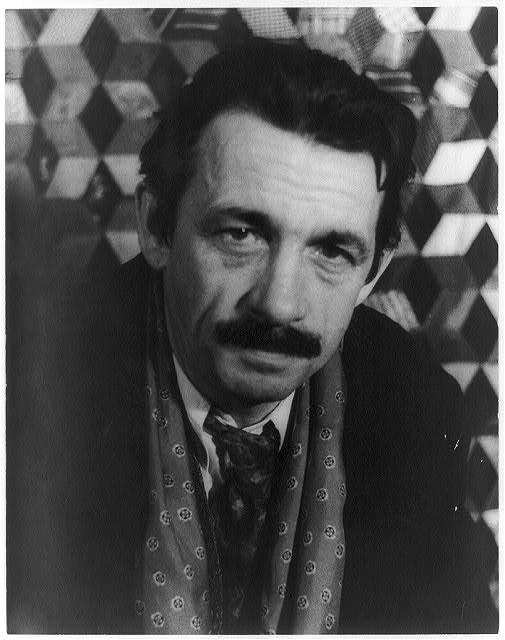Over the Christmas break, I went to the Nelson-Atkins Museum of Art in Kansas City to see a special exhibit called American Epics: Thomas Hart Benton and Hollywood. I’ve always liked Benton’s artwork. Each piece tells its own story, and his murals show aspects of an era or of our nation’s history so vividly that they become visceral and real. To call his larger works “American Epics” seems about right to me.

I knew of Benton as an artist of paintings and murals, but I hadn’t realized that he painted movie sets for silent films, illustrated books, produced promotional pieces, and sold low-cost lithographs to make his work accessible to everyone. The Nelson-Atkins exhibit displayed many of Benton’s works in all these genres, often in juxtaposition with movie clips from the same era depicting the same themes Benton portrayed in his art—the development of a nation, war, cultural change, and racism.
The Nelson-Atkins brochure for the Benton exhibit states that when he went to Hollywood in 1913, he “became acutely aware of the shift of contemporary storytelling toward motion pictures.” He developed the desire to depict epic themes on canvas, as the movies did on screen.
I couldn’t take photographs in the exhibit, or I would include them in this post.
Featured in the Nelson-Atkins exhibit was Benton’s mural series American Historical Epic which he painted between 1920 and 1928. I particularly enjoyed this series. Many of its panels depicted western expansion in the United States—the founding of our nation, pioneers crossing the land, and Native Americans mourning “The Lost Hunting Ground” (the name of one of the paintings).
Benton’s painting of the Oregon Trail captured the essence of how I have felt about our ancestors who crossed the plains and mountains seeking better lives for themselves and their families. Juxtaposed with Benton’s painting of the Oregon Trail was a clip from the movie The Big Trail. This clip showed emigrants lowering their covered wagons down an almost perpendicular slope—a scene that could have come out of my novel, Lead Me Home. I haven’t seen The Big Trail, but I’m going to look for it.
Artist Thomas Hart Benton himself had a family history associated with the West. Senator Thomas Hart Benton from Missouri was the artist’s great-great-uncle. The artist’s own father, Maecenas Benton, was a U.S. Congressman from Missouri.

And I have wondered whether there was any connection between the Bentons of Missouri and my own family. My great-grandfather’s name was Thomas Benton Hooker, born in Oregon in 1879. Senator Benton was a famous figure in the West, because of his advocacy for emigrants to the West, including support for his son-in-law John Fremont’s explorations. Counties in both Oregon and Washington (along with counties in many other states) are named for Senator Benton. So it might simply be that my ancestors revered the Benton name, and not that they knew any of the Missouri Bentons personally.
As I looked at artist Benton’s murals in the exhibit, it dawned on me that in my novels about the Oregon Trail and the California Gold Rush I am trying to do the same thing with words that he did in oils. I want to depict an era and an epic. I want to give the flavor of how these people—our ancestors—lived in a difficult age and how they battled the land to carve out a home for themselves and their families.
If I can get readers to reflect just for a moment on the fortitude and resourcefulness that made our nation great, then I will have been successful.
Writers, what do you want your books to mean to readers?




Theresa, I think we have the same heart! Those were my motivations when I wrote
“The Late Sooner.” You have done an excellent job in your book making those characters become real people–ones to care for and root for.
Thank you, Sally.
Theresa
I knew of Benton as an artist of paintings and murals, but I hadn’t realized that he painted movie sets for silent films, illustrated books, produced promotional pieces, and sold low-cost lithographs to make his work accessible to everyone.
My husband and I had the exact same experience at the exhibit! I knew Thomas Hart Benton as a Kansas City artist who did important work, but I didn’t realize his art was so influential in film, tv, and books. (Can you imagine writing a book and having your publisher say, “By the way, we found an illustrator…Thomas Hart Benton!”) I loved the flow of the exhibit.
I think my favorite painting was the one with the wagon crossing the Missouri during a storm. We all know that drama. And I think that’s what I want in my books…capturing a universal experience and making the reader feel it in a new or different way.
“capturing a universal experience and making the reader feel it in a new or different way.”
Diana,
What a wonderful goal for your writing!
Thanks. Theresa